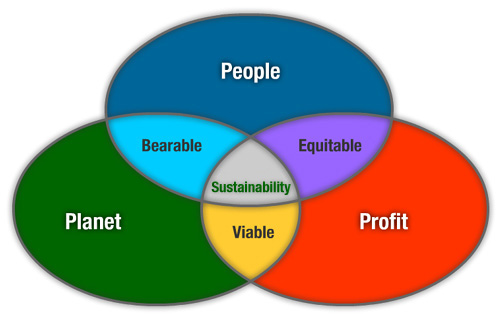Summary: Provides resources to support build of Triple Bottom Line as foundation of The Business of Sustainability shift.
 The Triple Bottom Line is basic to the Economics of Sustainability and is built in conjunction with a PowerPoint presentation for class use. The image to the left illustrates the basic notion of Triple Bottom Line. A related concept is Corporate Social Responsibility.
The Triple Bottom Line is basic to the Economics of Sustainability and is built in conjunction with a PowerPoint presentation for class use. The image to the left illustrates the basic notion of Triple Bottom Line. A related concept is Corporate Social Responsibility.
For a lively example of a business response to the challenge of the Triple Bottom Line, see Bloomberg Sustainability News site, whose mission states:
"At Bloomberg, being sustainable means managing our business better by integrating environmental, social and economic considerations into our operations, as well as our products and services. Sustainability combines corporate citizenship, risk management and strategic opportunity – driving our operating costs down, our revenues up, and influencing wider adoption of sustainable practices across the business community."
However, the Triple Bottom Line creates controversy and even opposition. The Triple Bottom Line violates a cardinal maxim of orthodox classical economics since Adam Smith, who proposed that by pursuing self-interest, the maximum good of all will be achieved. This is the seminal doctrine of the Invisible Hand that affirms free market capitalism and excoriates government intervention in markets. Thus, the Triple Bottom Line contradicts conservative theory, strongly held among business proponents.